
It's a gloriously sunny September day in the Veneto and we are zipping across the sea on a shuttle boat, headed for the beautiful Venetian island of Murano. As introductions to a city go, this one was hard to beat. A warm breeze whips our hair as we gaze across the turquoise lagoon which is glistening in the early afternoon sunshine. Up ahead, features of that iconic skyline come into view with its myriad of spires, towers and turrets. We are enraptured, like children. And straight ahead lies Murano, our home for the next six nights, its brightly-painted facades and boats appearing in a riot of colour - a view to take your breath away. We grin gleefully at each other. Welcome to Venice!
Venice is made up of a series of neighbourhoods or sestieri which are all interlinked by bridges and accessible from each other on foot: Cannaregio, Castello, San Marco, San Polo, Santa Croce and Dorsoduro. The islands of Giudecca and San Giorgio Maggiore lie to the south and are considered part of Dorsoduro. And to the north-west you'll find the island of Murano, known the world over as a centre for artisan glassmaking. Each neighbourhood has its own distinct characteristics and its own charms, and each one is worth visiting for entirely different reasons.
Warrens of tiny streets reveal treasures and endless curiosities around every corner: unassuming churches are home to some of the world's greatest masterpieces while resplendent palazzi stand side-by-side with crumbling but beautiful residential homes. Its finest moments can be found, not in the tick-the-box tourists sights, but entirely for free in the hidden courtyards, tiny piazzas and along the banks of its many canals. Lose the itinerary and surrender to getting lost.

Below is a mere snapshot of each of these districts - a flavour of what to expect. To do more would warrant a novel. But if you're looking for a longer read, check out Venice by one of our greatest living travel writers Jan Morris. It's a wonderfully evocative love story to one of the world's most extraordinary cities.
Disclosure: some of the links on this site are affiliate links with companies I have chosen to partner with. If you make a purchase through these, I may receive a small commission at no extra cost to you. Thank you for your support!
Venice Neighbourhood Travel Guide: Exploring its sestieri
Venice - 1500 years worth of secrets and beauty: a fun and interactive scavenger hunt
Interested in seeing one of the most lavish hospitals in the world? Or a tower designed to be climbed on horseback. What about a submerged crypt? ClueGo trail is a fun app to use on the go. Part self-guided tour and part scavenger hunt, the app allows you to have an immersive and interactive experience through the city, following a trail of fascinating stories. Your powers of observation and creativity will be tested to solve the clues and riddles to get from one destination to the next. It's a fun and unique way to experience a city, and you can do it at your own pace.
Price: €17.99 for a max group of 5 people. It's a 3.5 km trail with 11 stops and 11 riddles. Join the fun here
Good luck!
Cannaregio

For those who arrive by train, Cannaregio will be your first introduction to the city. And what an introduction that is. Exit the Santa Lucia station onto the Grand Canal to views that will literally make your jaw drop. Directly opposite stands the majestic domed church of San Simeone Piccolo; turn left along the canal to admire the exuberant Baroque facade of Santa Maria di Nazareth.
Understated and distinctly untouristy for the most part, Cannaregio is home to the city's Jewish quarter known as the Ghetto. This peaceful district is perfect for aimless wandering and there are pretty squares around every corner. Strada Nova is a bustling and popular shopping destination, while side streets are home to a variety of vintage and craft shops.
Cannaregio highlights
There are no shortage of beautiful churches in Venice but some will stop you dead in your tracks. Above is the Chiesa di Santa Maria Assunta, close to the Fondamenta Nuove vaporetto (passenger ferry) stop. An opulent 18th century church in the Baroque style, the facade is elaborately decorated and divided by eight columns, each topped by a sculptural figure. Between the columns are niches which also contain intricately carved statues. These twelve figures represent the apostles and are extraordinarily beautiful and highly-detailed, particularly their facial features and the swirling drapery. Inside you'll find works by Titian, Tintoretto and Sansovino.
Admire the grand mansions and the Palazzi of the Grand Canal for the price of a Vaporetto ticket... Jump on at the main train station and bag yourself an outdoor seat to enjoy the best canalside views, travelling the length of the Grand Canal as it snakes and weaves its way through the centre of venice. It's a fabulous way to get a sense of the city, and to enjoy its unique architectural treasures.

Eating and Drinking
This is one of the best districts for casual dining (Castello is also notable - see below). On the canal banks north of the Campo del Ghetto Nuovo, you'll find a strip of cicheti (Venetian tapas) bars running along Fondamenta della Misericordia and Fondamenta dei Ormesini which come alive at 6pm each day - it's aperitivo time. You'll notice lots of people enjoying that iconic Venetian aperitivo, the Spritz, either with Campari or Aperol. This was one of their national drinks, long before it became trendy and overpriced in the rest of Europe.
Cast aside any notions of a sit-down meal but bar-hop instead. Complimentary bowls of crisps and meaty olives are brought to the table with any drinks order, as par for the course, but you can fill up on some super-tasty crostini (open sandwiches) and other simple bar snacks for a nominal price.
Castello

Castello was the neighbourhood that stole our hearts. The easternmost and largest district of Venice, it is home to the Arsenale shipyards, the heart of the naval industry in Venice from the 12th century. Today of course, it's synonymous with the Venice Biennale, which showcases art and architecture on alternate years.
Castello highlights
Less than 2 kms from tourist-swamped San Marco, the peaceful streets of Castello feel like a world away. The best way to see it is on foot, traversing pretty squares and enjoying the variety of facades: some with brightly painted shutters, others with colourful window boxes overflowing with flowers.
A six or seven kilometre walking route, starting at the Ospedale or Celestia Vaporetto stops on the northern bank, and ending at the leafy Giardini Pubblici at the southernmost tip, is the best introduction to this lovely neighbourhood. Give yourself plenty of time - there are many distractions on the way. A good starting point is to follow the coastal boardwalk eastwards and enjoy some truly gorgeous views across the lagoon to Murano and Cimitero di San Michele.
You'll eventually arrive at the north end of the Arsenale Basin to encounter some of the lovely old redbrick shipyard buildings with intricate ironwork details on the windows and doors.

It's incredibly still and quiet in this part of the city, especially on the northern banks, though the Architecture Biennale was in full-swing on the other side of the water. But before you head south, there's a piece of art that you absolutely cannot miss...
Building Bridges by Lorenzo Quinn

This extraordinary sculptural bridge was one of my favourite discoveries during our time in Venice. Building Bridges is the work of contemporary Italian artist Lorenzo Quinn. Six pairs of monumental hands are conjoined across the basin of the Arsenale, said to stand as a symbol of our commonality. Such a beautiful sentiment and I found it profoundly moving. The hands represent six of humanity’s universal values: Friendship, Faith, Help, Love, Hope and Wisdom.
Porta Magna and Arsenale
At the bottom of the Basin you'll find Porta Magna, the imposing entrance gates of the Arsenale. This was the first Renaissance monument in Venice, guarded by two large marble lions on either side and one above the door. There are a number of casual outdoor dining spots right on Campo d'Arsenal to enjoy a Spritz or a coffee. Surprisingly inexpensive too, considering the fabulous view. The architecture is seriously impressive, and the sculptural detailing is beautiful.
The southern end of the Castello promontory is home to two gorgeous green spaces: Giardini della Biennale and Giardini Publicci.
Giardini della Biennale
Though parts are inaccessible without a ticket during the Biennale, you can still enjoy strolling the length of this lovely tree-lined avenue. We were lucky enough to catch it as its autumn colours were beginning to show. Start at the monument to national hero Giuseppe Garibaldi who stands proudly upon a hill, and make sure to take a peek in the pond below - it's full of turtles. Entirely unexpected. At the base of the hill stands a smaller figure: a partisan named Joseph Zolli. His facial features are beautifully rendered, and his expression exhibits a real gravitas.
At the end of the avenue, Castello's spectacular waterfront comes into view through the trees. Turn onto the promenade to take in some of the best views in Venice as the vast expanse of the lagoon opens out in front of you - it's a stunner. Across the water is the pristine white facade of San Giorgio Maggiore, while to the right are some truly fabulous views of St Mark's square.

At the time of our visit, there were some cool outdoor art exhibitions and public sculpture on show in parks and squares along the waterfront, including the Giardino della Marinaressa. This is a part of Venice I'd never experienced before and it seemed a world away from the tiny warren of streets and canals we usually associate with the city. It reminded me a little of Nice, and was definitely one of my favourite places to spend time, especially when the sun was shining.
Continuing left along the waterfront will eventually bring you to the lovely Giardini Publicci, laid out under Napoleon as the city's first public green space. Beloved of joggers, walkers and people-watchers, it very much has a local vibe and attracts few tourists outside of Biennale season. Its leafy paths provide welcome shade from the sun and the views from the waterfront are fabulous. It's an ideal spot to take a breather after a day's exertions, and one of the best places to enjoy a sunset.

Eating and Drinking
At this point you'll have earned yourself a refreshing aperitivo. On the edges of the Giardini Pubblici you'll find Vincent's Bar, a gem of a place with an almost entirely local clientele. Staff are warm and friendly, and the Campari Spritz is one of the best in the city. A mere €4 too. Vincent Bar, Viale IV Novembre, 36
Dive into the aperitivo scene on the Castello Cicheti Trail
Just off the waterfront at Riva Sette Martiri, you'll find Via Giuseppe Garibaldi, unquestionably one of the most vibrant parts of the city. A street teeming with life from 6pm every day, this is where locals and students flock to street-side tables to enjoy a drink and some casual cicheti. The atmosphere is buzzy and you can take your pick of any number of places to enjoy some cheap and cheerful snacks with your aperitivo. We opted for Basegó and Strani. Here it feels like you are at the heart of a real living city, and not a museum set. Friday and Saturday nights here are particularly groovy and we had one of the best experiences of our holiday on these streets. And with views like these from the waterfront, Castello is hard to beat.

Top Castello meals
Two of the standout meals of our trip were in Castello. First up was Ristorante Santa Maria Formosa on Campo Santa Maria Formosa. Here we nabbed the last outdoor table of the evening on this lovely square, overlooked by the 16th century church of the same name. We tucked into a Burratina salad with the freshest ingredients, and sampled the Venetian speciality Baccalá (whipped dried cod) which just melts in your mouth. Martin's Tagliata got a massive thumbs up, while my tagliatelle with porcini mushrooms was cooked to al-dente perfection. An excellent bottle of Bardolino was €26 and we were given two digestivi on the house.
Spaghetteria 6342 Alle Corte, Calle Bressana, Castello 6319
Enjoy a modern twist on traditional recipes from the Venetian lagoon in this contemporary trattoria. Seafood is king here, and you can also expect plenty of fresh, seasonal produce. Staff were young and friendly and the atmosphere relaxed. In the corner was a guy playing guitar, occasionally accompanied by the characterful manager with his pinstriped suit and handlebar moustache.
Make sure to arrive hungry. The huge ball of Burrata managed to defeat the two of us, but the raw porcini mushroom salad with balsamic was a nice light contrast. However, it was the homemade black & white ravioli filled with seabass that was the standout dish of the evening.
Tip: book in advance and request the prime table in the window, overhanging the canal.
Dorsoduro, Giudecca and San Giorgio Maggiore
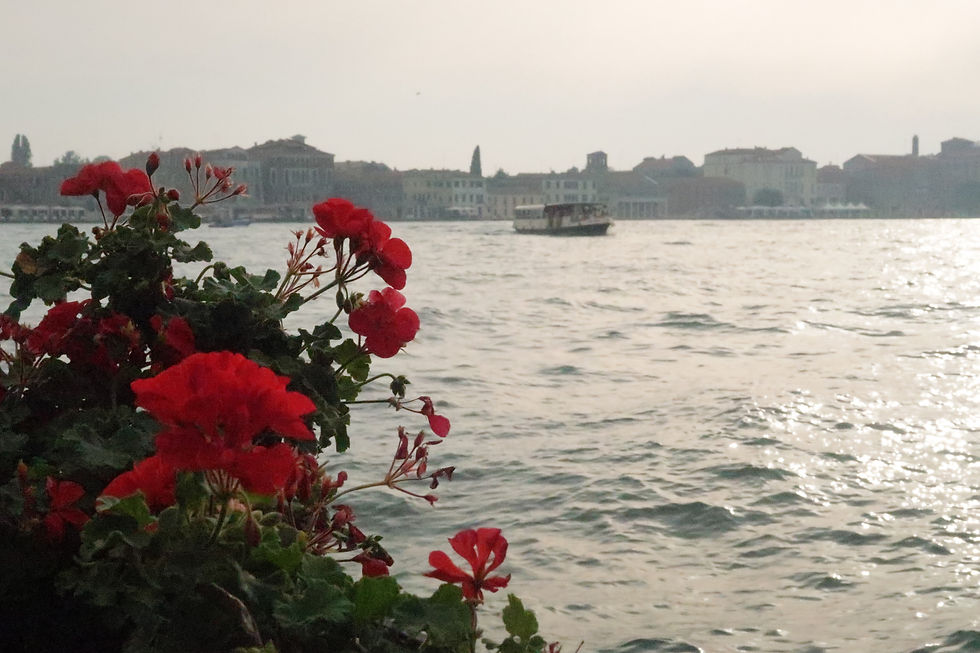
Nestled between the Grand Canal to the north, and the Giudecca Canal to the south, Dorsoduro offers up some of the city's most picturesque vistas and iconic viewpoints. The pace of life slows down a little here, and the vibe is more relaxed. It's a very pleasant part of the city for aimless wandering, to enjoy the hodge-podge of styles of the charming residential streets. Home to the Ca’ Foscari University and the IUAV University of Venice, there is a huge student population in this neighbourhood, bringing with it a cheap and cheerful café scene, and some lively spots for an evening aperitivo or two.
Art lovers will be in their element here with something to suit every taste. There's the Gallerie dell 'Accademia with its impressive Renaissance collection, Punta della Dogana with its focus on the contemporary and avant-garde, the magnificent art-filled Baroque palace of Ca' Rezzonico and of course, my personal favourite, the Peggy Guggenheim Collection. Across the water in Giudecca is Il Redentore, one of Palladio's churches, while his masterpiece, San Giorgio Maggiore, is on an island of its own and there to be admired by all as they stroll along the Zattere waterfront.
Highlights: Dorsoduro, Giudecca and San Giorgio Maggiore
Fondamenta delle Zattere
One of this city's greatest pleasures has to be an evening stroll along Fondamenta delle Zattere, the waterfront promenade which runs from the San Basilio Vaporetto stop all the way to the Laterna Punta della Dogana at its easternmost tip. On a still, hazy evening, the sweeping views across the lagoon are intoxicating; the silver glistening waters of the Giudecca Canal and the pinkish hues of the sky complemented beautifully by the colour-coordinated street lamps and floral features dotted along the walkway.
Peggy Guggenheim Collection - Palazzo Venier dei Leoni, Dorsoduro 701

"To live in Venice, or even to visit it, means that you fall in love with the city itself. There is nothing left over in your heart for anyone else" Peggy Guggenheim
The remarkable Peggy Guggenheim made Venice her home in 1948, acquiring this magnificent palazzo on the Grand Canal to showcase her vast, and at the time radical, collection of modern art. Today we can enjoy the fruits of her labour as we wander through bright rooms filled with work by the giants of modern art such as Kandinsky, Klee, Picasso, Mondrian and Dalí. She also became a champion for contemporary Italian art which led to a resurgence of appreciation for Morandi, De Chirico and the Futurists.
Make sure to venture onto the terrace which opens to the Grand Canal, accessible only from one of the gallery spaces. The cheeky but wonderful Angel of the City by Marino Marini greets passing Vaporetto users and gondoliers, and is clearly very happy to see them. The views are pretty jaw-dropping too.
A highlight is the leafy sculpture garden which has some fine pieces by Giacometti, Brancusi, Pomodoro and Anish Kapoor. Fascinating fact: this is Peggy Guggenheim's final resting place, getting special dispensation from the City of Venice to be buried here alongside her beloved dogs.
Finish off your visit and enjoy the views over the sculpture garden with a refreshing drink or snack in the Pavillion Café. Staff were friendly, the Spritz was excellent and a red Chardonnay proved to be an unusual but elegant break from the norm. Surprisingly inexpensive too, considering the location
Booking online is essential. Full-price tickets €16.50. Discounted rates available. Children - €1.50
Peggy Guggenheim Collection, Palazzo Venier dei Leoni, Dorsoduro 701
Basilica di Santa Maria della Salute, Dorsoduro, 1
The Basilica di Santa Maria della Salute is one of the most iconic Venetian landmarks: a striking domed Baroque church with a unique octagonal design, built during the 17th century to commemorate the end of a terrible outbreak of the plague. Located at the entrance to the Grand Canal at Lanterna Punta della Dogana, it looks directly across to another Venetian icon, San Giorgio Maggiore, as the vast expanse of the lagoon spreads out before you. It stands, of course, that the best viewing point for the full scale of Salute is from the Campanile or bell tower of San Giorgio - more on this below.

While the interior is quite austere and lacking in decoration, an otherworldly light fills the space from the dramatically high domed ceiling. Make sure to visit the Sacristy with its glorious collection of Titian and Tintoretto masterpieces.
The Basilica is free to visit but there is a €4 charge to visit the Sacristy.
Il Redentore, Sestiere Giudecca, 30133

One of Palladio's Venetian masterpieces, this striking white marble church with its harmonious classical proportions stands on the edge of the water on the island of Giudecca, clearly visible from Piazza di San Marco. Commissioned from the architect in 1577, the church was dedicated to the Holy Redeemer, calling on his intervention to deliver the city of Venice from a serious outbreak of the plague from 1575-1576.
The interior takes its inspiration from the architecture of Roman baths, lined by a series of vaulted spaces and lit from above by clerestory windows. Decoration is kept to a minimum, though there is real beauty in its simplicity.
Church of San Giorgio Maggiore, island of San Maggiore, Giudecca

One of the most recognisable images of Venice, and certainly one of the most photographed, is the second Palladian masterpiece San Giorgio Maggiore. Completed in 1610, its white Istrian stone appears to gleam in the sun but this was no accident - the architect intended it to stand out beautifully against the blue waters of the lagoon. It was situated for maximum impact, on an island of its own and angled towards Piazza San Marco. It's a dazzling sight. Inside you'll find late paintings by Tintoretto.
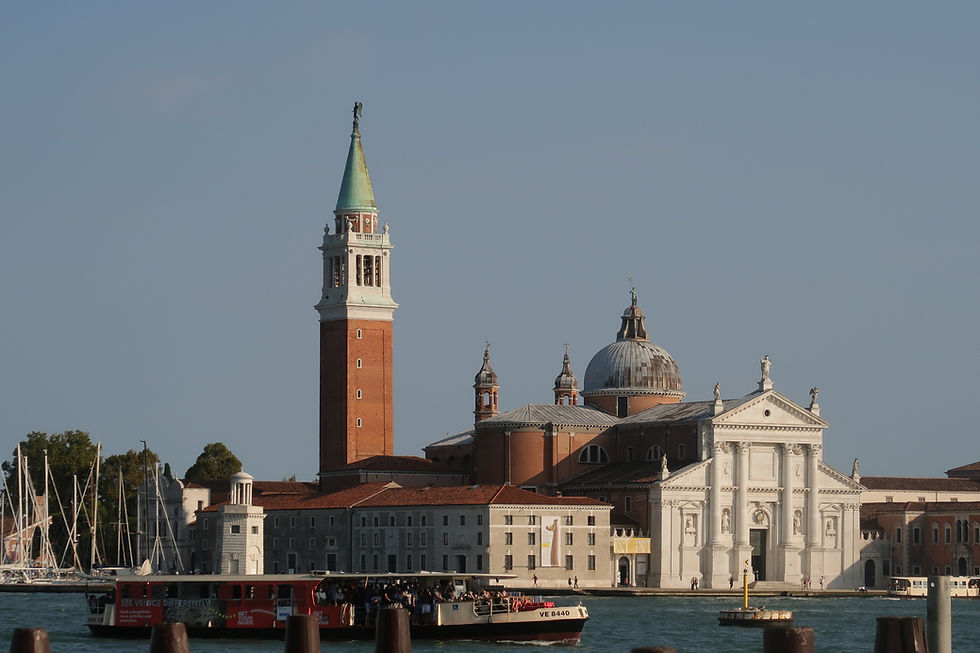
Top tip: For postcard-perfect views of Venice and Piazza San Marco, take the lift to the top of the Campanile di San Giorgio Maggiore. While crowds snake around the Campanile at St Mark's, here you won't have to queue. It's a fraction of the price too.
Eating and Drinking
Best for a classy lunch with a view. Overlooking the Giudecca Canal and with seats literally right at the water's edge, this was our chosen spot to clear our fuzzy heads from our friends' wedding the night before. An amuse-bouche was beautifully presented and was a good indication of what was to come. Martin went off-grid and opted for the burger while I stayed traditional with a prawn pasta. Service was friendly and efficient but the views were off-the charts. Definitely somewhere to linger as the sun sets.
El Chioscetto, Fondamenta Zattere Al Ponte Lungo, 1406/A
When it comes to a casual bar with a view, El Chioschetto is hard to beat. Overlooking the Giudecca Canal, reasonably-priced drinks are served from a small kiosk. It tends to be busiest at sunset as this is one of the prime viewing spots in the city. Apparently they have live gigs during the summer months too. One to come back to.
Campo de San Basegio, Dorsoduro
Inland from the San Basilio vaporetto stop, you'll find Campo San Basegio, a square teeming with life once the clock strikes 5pm. Yep it's aperitivo time again. There are a few grungey little bars along the main strip, serving a mix of students and locals. The one at the end has a good range of IPAs, which is quite unusual in Venice, and prices are low, in keeping with its student population.
San Polo and Santa Croce
The streets of the twinned neighbourhoods of San Polo and Santa Croce look deceptively low-key but here you'll find some of the most significant works of art in the city.
Highlights of San Polo and Santa Croce
Church of San Stae, Santa Croce
Overlooking the Grand Canal at the Vaporetto stop of the same name you'll find the magnificent 18th century Church of San Stae. The lavish façade is brimming with rich decoration. Stand at the door and look up - a series of figures overhang the broken pediment while overhead a putti is precariously balanced above the door.
I Frari - Basilica S.Maria Gloriosa dei Frari, Campo dei Frari, San Polo, 3072
This 14th century Gothic basilica, rendered in Italian red brick, is home to one of the most revered paintings by Titian, his 1518 Assumption of the Virgin. Sadly it was under restoration at the time of this visit with a reproduction hanging in its place but I was lucky enough to see it one cold November day, about twenty years ago, when I convinced the kindly janitor to let me in for a quick peek before he closed up.
The altarpiece is the focal point of the church, its larger then life-sized figures rendered in the most vibrant, primary shades which seem to glow from within. The composition of the painting was superbly designed by the artist to lead the eyes upwards in a dynamic, swirling motion from the apostles at the bottom, to Mary in the centre, and finally to God at the top. However, if you miss out on seeing the above in the flesh, then you can enjoy Titian's Pesaro Altarpiece which is still on view. Completed in 1526, the vibrancy of the colours to present day is remarkable to see, as is his unconventional perspective in composition.
Sadly the wonderfully bizarre pyramidal tomb of Antonio Canova was also under restoration but is a must-see for future reference. Containing the heart of the neoclassical sculptor, this enormous white marble tomb was created by five of his students after their master’s death in 1822. His membership of the Freemasons is referenced by the pyramid shape and other Masonic symbols.
Entry - €3. €1.50 discount for students. Children under 12 go free.
Scuola Grande di San Rocco, Campo San Rocco, San Polo, 3052

A trip to Venice is not complete without paying a visit to the magnificent 15th century Scuola Grande di San Rocco. Named after St Roch, the patron saint of plague victims, it's best known for the remarkable cycle of over sixty paintings by Tintoretto which adorn its opulent rooms and ceilings, and to which he dedicated over twenty years of his life. It's an almost overwhelming experience and hard to take it all in, so give yourself time to enjoy it.
On the ground floor you'll see works by other artists such as Titian, Giorgione and Tiepolo, but when you ascend that fabulous Scarpagnino Staircase to the grand Sala Capitolare, there's only one star of the show. His high-action New Testament scenes are located in the ceiling panels, while Old Testament scenes cover the walls. You'll also notice some unusual wooden allegorical sculptures by Francesco Pianta, one of which is a portrait of Tintoretto. They date to the mid 17th century and their strangeness is even more enhanced by some dramatic lighting.
Entry - €10. €8 concessions. €3 for schools.
Eating and Drinking
For a fun night out, try Vineria all'Amarone, a funky little wine bar offering a vast selection of Italian wines by the glass or bottle, with some excellent food to boot. Better still - opt for the Wine Flight which is a tasting menu of five different regional wines for €38. We worked our way through the changing flavours of some of Italy's best loved wines: Pinot Nero, Montepulciano, Barolo, Brunello di Montalcino and finally, a big and bold Amarone, from which the bar takes its name. We were given some tasting notes, and a notepad to jot down our own.
We thoroughly enjoyed our journey through the vineyards of Italy, helped no end by the enthusiastic and friendly manager who was only too happy to answer our questions. Some hearty food provided some much-needed soakage, and we tucked into some prosciutto and mozzarella, followed by a comforting bowl of porcini mushroom risotto (me) and gnocchi in an Amarone sauce (him) Delicious! Our new friend also threw in two Grappas on the house.
Calle Sbianchesini, 1131, San Polo
San Marco

At the heart of this beautiful city you’ll find the district of San Marco and its Piazza, the quintessential image of Venice. It's difficult to take in the number of world-famous attractions that are jam-packed into this area alone, and some visitors never venture beyond its boundaries. Understandable, but you'd be missing out on all those magic off-the-beaten track discoveries. Others are reluctant to go near it, to avoid the inevitable hordes of visitors congregating on every square inch of space around Piazza San Marco.
However, for the sheer hit-you-in-the-solar-plexus impact of that glorious first sighting, you can't miss it. It feels so familiar yet so fantastically exotic all at once. My only piece of advice - choose carefully what your priorities are, and don't try to see everything. It's barely possible in a lifetime, let alone in a holiday, and you risk burning yourself out. Enjoy the vertigo-inducing views of the Campanile from ground level only, avoiding the queues which snake around the square. Instead, take the Vaporetto across to the bell tower at San Giorgio Maggiore to enjoy the full spectacle of Piazza San Marco from across the water. It's half the price and you won't have to queue.
Highlights of San Marco
Basilica di San Marco, Piazza San Marco, 328

The exuberantly mosaiced and domed 11th century basilica is one of the city's most in-your-face spectacles. East meets west in an architectural mish-mash of styles with a Greek cross layout topped by Byzantine domes, and walls clad in marble from places as far afield as Syria, Palestine and Egypt. The facade comprises five niched openings housing shimmering mosaics and topped by elaborate stone arches.
The interior is no less extraordinary with over 8000 square metres of glittering golden mosaics adorning the walls, vaults and domes, depicting stories from the Old and New Testament, allegorical figures, and scenes from the lives of the saints.
For information on ticketing, click here
Palazzo Ducale

In perfect contrast is the elegant Palazzo Ducale, or Doge's palace, with its striking Veronese pink marble and white Istrian stone. Destroyed by a fire in 1577, it was restored to its original Gothic glory by Antonio da Ponte, renowned architect on the rebuild of the Rialto Bridge, with later Renaissance and Mannerist additions. The seat of the Venetian government for over seven centuries, the Palazzo was not only home to the Doge’s private apartments and council chambers, but also the city’s courtrooms and a prison.
Inside, expect opulent rooms filled with art from the likes of Titian, Tintoretto and Veronese, alongside a room designed by Palladio and a golden staircase by Sansovino. Don't scrimp on time here - give yourself half a day at least to take it all in.
For information on all the ticketing options, including a Museum Pass, click here.
Eating and Drinking
Venice is frequently referred to as an expensive city but the truth is, there is great value to be found here, if you're prepared to veer a little off the tourist track. And by a little, I mean less than a kilometre. Prices for lunch and dinner are cheaper than in Ireland, and wine drinkers can enjoy an excellent glass from between €4 - €6. However, if you have your heart set on eating and drinking on St Mark's Square, you'll pay a surcharge for the pleasure. Enjoy a coffee like the locals standing up at a bar, you'll pay less than €2. Add in a seat with a view of Piazza San Marco and you could easily find yourself paying €6-8. Decide for yourself if it's worth it. We decided it wasn't.
Murano

If you baulk at the eye-wateringly high hotel prices on the mainland, then Murano is a great option to consider as a base. It's easily accessible by Vaporetto, and is stunningly beautiful to boot. Wander along the Fondamenta dei Vetrai and Ramo di Mula to admire the work of the glass masters. One of the best is De Biasi on Fondamenta Navagero with its cutting-edge and contemporary statement necklaces and earrings.
It's a charming and peaceful part of the city with a laid-back vibe that makes you instantly relax and switch pace. This is the place to enjoy the small pleasures of life: sitting on a small square with a glass of wine and a simple bowl of pasta; having a canal-side aperitivo while the evening unfolds in front of your eyes in all its glorious hues.
Murano highlights
Be sure to pay a visit across the water to the Cimitero di San Michele, just one stop from Colonna on the Vaporetto.

Ok so maybe visiting a cemetery is not top of your list when on holidays, but I promise you it's a special place. On a small island of its own and cocooned by trees, it's a haven of tranquility - about as far away from the hustle and bustle of Venice as you can imagine. It also boasts some beautiful original architectural features including the immense Gothic entrance gate that leads from the churchyard to the monastery, the brick bell tower dating to 1456 and a striking Renaissance church.
A city cemetery established by Napoleon, people come here to pay their respects to American poets Ezra Pound and Joseph Brodsky, and to Russian composer and musician Igor Stravinsky who was also buried here with his wife Vera. Today it is still a functioning contemporary cemetery.
Free entrance. Vaporetto stop: Cimitero
Church of Santa Maria & San Donato. Campo San Donato 11
The church is one of the oldest in the Venetian lagoon, dating back to the 7th century, rebuilt in the 9th and with later additions in the 11th. An impressive bell tower, also in red-brick, stands separately. Make sure to pop inside to see the fabulous 12th century Byzantine mosaics on the floor, made up of porphyry, serpentine, and other precious Mediterranean stones. Decoration comprises figurative images of animals as well as symbolic geometric patterns.
Church of San Pietro Martire, Campiello Marco Michieli 3
With a simple red-brick unassuming façade, this church is located just off Fondamenta dei Vetrai and is home to paintings by Tintoretto and Bellini. It's free to enter but like so many churches in Italy, you pay €2 to have them illuminated to view them in their full glory. Afterwards, cross the Ponte Longo to enjoy some lovely views across the water of the church, its late 15th century campanile and the beautiful Torre dell’ Orologio, or clock tower.

Where to stay:
We stayed at the Hyatt Centric Murano, located right on the canal front at the Museo Vaporetto stop and I couldn't recommend this hotel more highly. In fact, it's one of the best hotels we've experienced in Europe. It's a chain, but an exceptionally good one, spotlessly clean with large, bright contemporary rooms. Ours had a super-comfy king-sized bed with high-quality bed-linen. Decor is modern in muted tones but art lovers will enjoy the exuberant displays of Murano glass on display everywhere.
Hyatt Centric Murano Venice, Riva Longa 49, Murano
Bear in mind:

Staying in Murano may turn out to be a false economy in the longer term if you are planning on using the Vaporetto daily to get to and from the mainland. The ferry prices are not cheap at €7.50 for a single 75 minute trip. Travel cards are a better option if you're planning on multiple trips a day. We paid €60 each for a seven-day travel card but there are other options available. Click here for more info. Depending on what parts of the mainland you're travelling to, ferry travel can be slow, with multiple stops before you reach your destination.
Eating and Drinking
The Rivalonga Bar and Lounge is the hotel bar and runs along by the canal front - grab one of their outdoor tables in the evening and watch the sun go down across the lagoon. You can pick up an excellent glass of Bardolino for €6 or a Spritz for €7.
For late-night drinks, hotel residents have access to the outdoor terrace which boasts couches and huge cushions, and some occasionally groovy tunes. Actually, this may be your only drinks option after a certain time of night. Venice is not traditionally known as a party city, and Murano certainly isn't. While its tiny streets come alive at 6pm aperitivo time, by 10:30 pm most people have retreated to their homes and bars are closed. Just something to bear in mind.

Despite its compact size, there are countless places to eat in Murano. The majority can be found along Fondamenta dei Vetrai, between the Colonna Vaporetto stop and the Ponte Vivarini, and have fabulous ringside seats to some of the most picturesque canal views. We opted for two spots on the other side of the island, quieter, but no less picturesque.
Al Canton, Campo S. Donato, 20

With views of the Church of Santa Maria & San Donato on one side, and the brightly-coloured houses and boats of the canal on the other, an outdoor table here is hard to beat. They offer a variety of simple but well-made dishes, and the service is friendly. The spicy Spaghetti all Buséra was a winner.
Osteria al Duomo, Fondamenta Andrea Navagero, 20/21
This is the place to go to in Murano for pizza. It can be hard to bag one of the few canal-side seats at the front of the building, but the walled garden at the back is pretty idyllic too, surrounded by trees. The vibe is casual but the pizzas are divine. And huge, so make sure to visit hungry. A cheap and cheerful dinner - two pizzas, four glasses of wine and a large bottle of sparkling water came in at under €50.
And that concludes my comprehensive neighbourhood travel guide to Venice. Let me know in the comments which part of Venice is your favourite
Happy travelling
xx




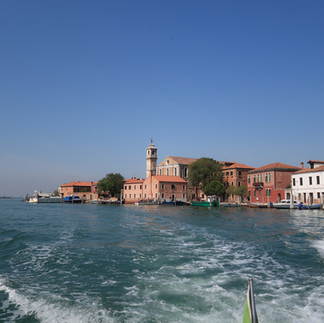

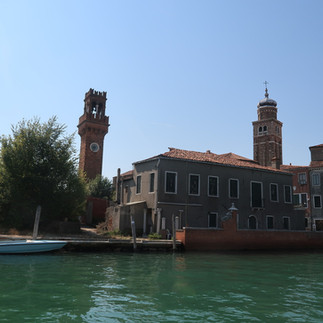











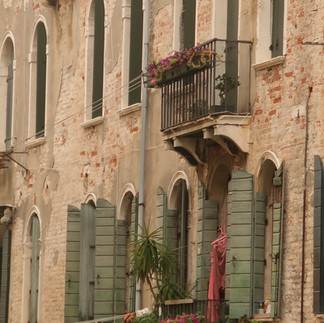
























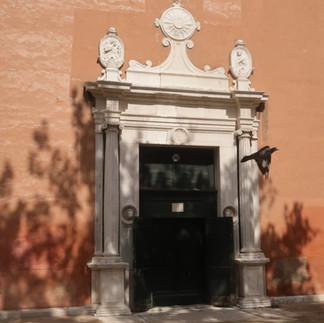











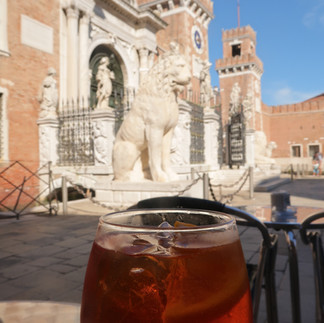



















































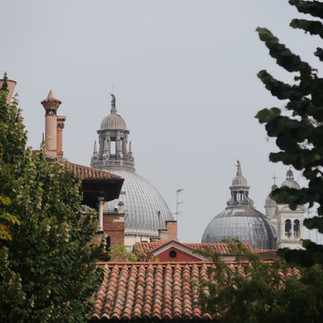

















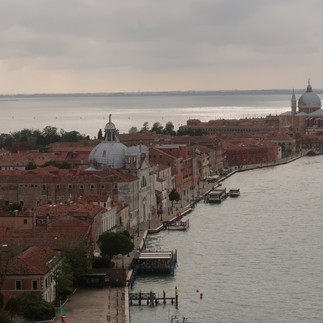















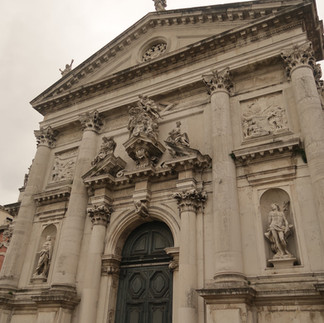

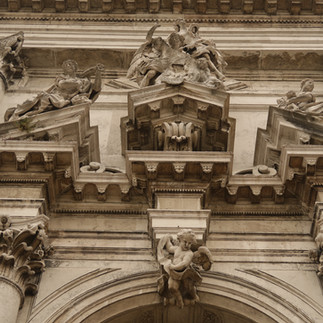

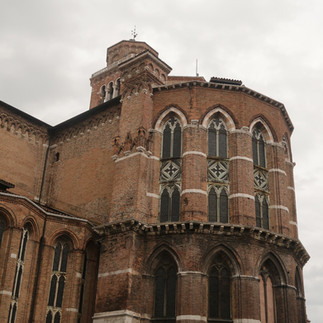











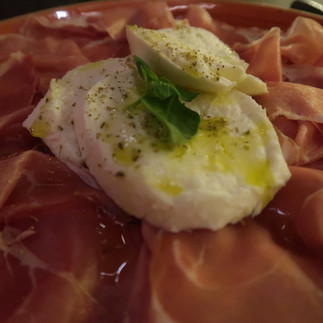



















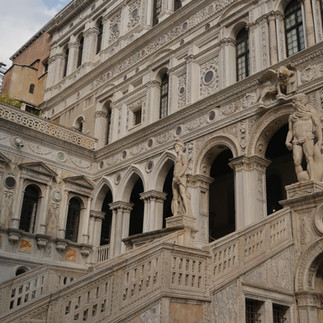
























Comments